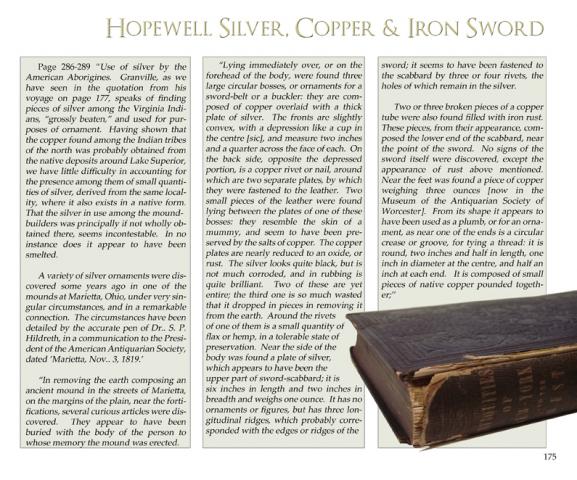Worrisome Question
Why is it that so many artifacts found in North America over the years have been called a hoax by most of the so-called archaeologists and scientists? Why do the “smart ones” seem to lack so much knowledge? Why did the Smithsonian hide artifacts and claim that all Native Americans were Savages? Most scientists don’t like discussing things that go against their pet theories. The map below was patterned after a map of Cyrus Thomas from 1891. Look at the amazing dates that are said to be during the Adena and Hopewell timeline in the Book of Mormon. Why would no LDS archaeologist even consider this? The non-Mormon scholars and archaeologists have no reason to lie about their findings. This is why we have so little faith in some of our Church historians who won’t even look or consider. It is very sad indeed.


For example, I have an acquaintance who is a well known professor in Utah who is a wonderful man, a great member of the Church of Jesus Christ of Latter-day Saints, and has spent over 30 years of research to find evidences of the Book of Mormon in Mesoamerica. His donors have spent millions of dollars researching all over the land of Mexico and Central America looking for any little proof of a connection to the Book of Mormon. He refuses to even consider artifacts in North America.
Here is a quote from another LDS researcher friend of mine who said, “Mesoamerica fits because of things like populations, writing systems, warfare, city-state governments, kings, raised highways, and so much more. This is not saying that the Nephites were the Maya. Rather, it seems that the Nephites were a small group affected by Mesoamerican culture.” These serious archaeologists searching in Mesoamerica have found nothing of substance, but only suggestions of why the Book of Mormon happened in Mesoamerica. Now understand, as a heartlander I don’t think I have all the answers either. I am just saying why not take all of this possible evidence of Nephites in North America and research it? Why not spend $1 million of the $8 million these LDS archaeologists just received, and search things in North America. They could still use the $7 million in Mesoamerica.
This is why almost all so-called evidence of the Book of Mormon in North America is called a hoax because it doesn’t fit their paradigm so they don’t want to explore it further, in case it goes against their belief. We have the same bias who believe in the heartland theory, but like me, most of us have studied the Mesoamerican theory for many years and found very little.
Recently this first acquaintance I mentioned earlier, spent a few days in Ohio with 4 non-Mormon PhD’s, scientists and archaeologists who were looking for evidence of ancient civilizations of Hebrew culture in Ohio. Combined they had over 90 years of archaeological experience of Ancient Hebrew existing in Ohio. We did find 7 ancient Adena roundhouses dated from about 400 to 200 BC, using magnetometry from Germany.* However not one of our non-Mormon friends could convince this acquaintance of mine to even consider looking in Ohio for Hebrew artifacts. Understand this event? A wonderful LDS archaeologist who is so focused in Mesoamerica that he won’t even look at this Hebrew evidence in North America. He doesn’t even want to take the chance that it is a possibility. You would think with Lehi being from the tribe of Joseph, and Mulek from the tribe of Judah and possibly existing evidence in North America, why wouldn’t that be something he would want to at least take a look at? It’s called confirmation bias, and we all do it. *See my other blog here. https://www.bofm.blog/in-search-of-the-lost-menorah-in-ohio/
This is why I think it is important for my readers to view all the information that is out there. I believe we should be open minded to all theories. It shows strength when we are willing to look at the other side which just strengthens our own resolve as we learn and pray about truth. As Moroni said, “we may know the true of all things.”
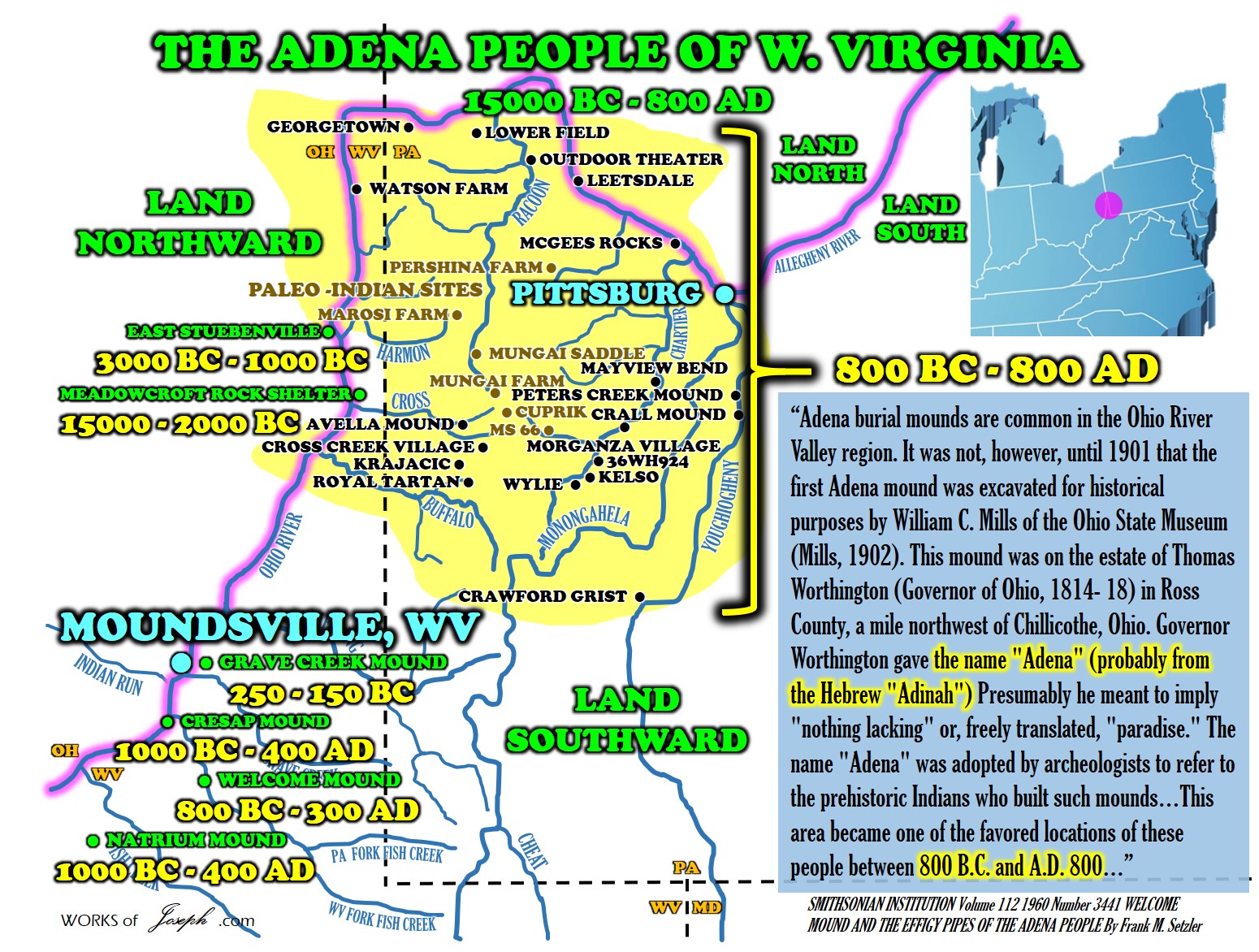
 The Grave Creek Stone (Left)
The Grave Creek Stone (Left)
Smithsonian photograph 90-9022
(MS 3146, E.H. Davis Collection, National Anthropological Archives)

The Grave Creek Stone was discovered in 1838 during the excavation of the Grave Creek Mound, in Moundsville, West Virginia, on the Ohio River, about 10 miles south of Wheeling. The stone, an actual photograph of which appears in Figure 1 above, was a small inscribed sandstone disk, about 1 7/8″ (4.8 cm) wide, and 1 1/2″ (3.6 cm) high. The reverse side was uninscribed.
In 1838, the mound was reported to have been 69 feet high and 295 feet in diameter at the base, making it the largest of the Adena mounds. Today the mound is preserved in the Grave Creek Mound State Park. According to the Park website, the mound is currently believed to have been built between 250 BC and 150 BC. Figure 2 below shows the mound in its present condition. Note the relative size of the cars and house.
Grave Creek Mound Archaeological Complex
|
|
The Mound |
The Adena People
About 1000 B.C. marks the beginning of a new period in North America. Called the Woodland Period, this period lasted until about 700 A.D. During this time, a new culture emerged and made significant settlements in what is now known as West Virginia. These people are known to us today by the general term the Mound Builders, so called for their practice of creating earthen burial mounds and other earthworks. The Mound Builders lived over a wide range from the Atlantic, the Midwest and the Ohio Valley to the Mississippi Valley. The term “mound builders” refers to several cultures that span a period of about 20 centuries.
The first group of people to develop this unique way of life were the Adena, from about 1000 B.C. to about 1 A.D. They had well-organized societies and lived in a wide area including much of present day Ohio, Indiana, West Virginia, Kentucky and parts of Pennsylvania and New York. A later group of Mound Builders, the Hopewell, lived from about 1 A.D. to 700 A.D. and represented a greater refinement over the earlier Adena culture. Other cultures extended Mound Builders to about 1300 A.D.
The labour of many people must have been required to build these mounds since they did not use the wheel and had no horses. The large amounts of earth had to be moved by the basket-load. Perhaps for this reason, the mounds were often used more than once. We find in many mounds there are multiple burials at different levels. Over time the mounds gradually increased in size.
Most of the people were cremated after death, placed in small log tombs and covered with earth. They often were buried in the flesh and more important people were laid to rest with a variety of artifacts such as flint tools, beads, pipes and mica and copper ornaments.
Grave Creek Mound is of the late Adena Period and was built in successive stages over a period of 100 years or more. We do not know why the Adena chose to build the particular mound on such a huge scale compared with other burial mounds in the area that generally range in size from 20 to 300 feet in diameter.
A typical Adena house was built in a circular form from 15 to 45 feet in diameter. The walls consisted of paired posts tilted outward, joined to other wood to form a conical-shaped roof. The roof was covered with bark and the walls may have been bark, wickerwork or some combination. They were extensive traders as evidenced by the types of ,material found in the mounds they constructed. Copper from the western Great Lakes region and shells from the Gulf of Mexico, all attest to the range of their economic activity. In addition, the culture also practiced agriculture, hunting and fishing.
About 500 B.C., the Adena culture began slowly to give way to a more sophisticated culture, the Hopewell. Although little remains of their villages, the Adena left great monuments to mark their passing, and one of the greatest of these in the Grave Creek Mound.” by The West Virginia Department of Arts, Culture and History See my blog about the Adena people here: https://www.bofm.blog/the-adena-culture-is-the-jaredite-culture/
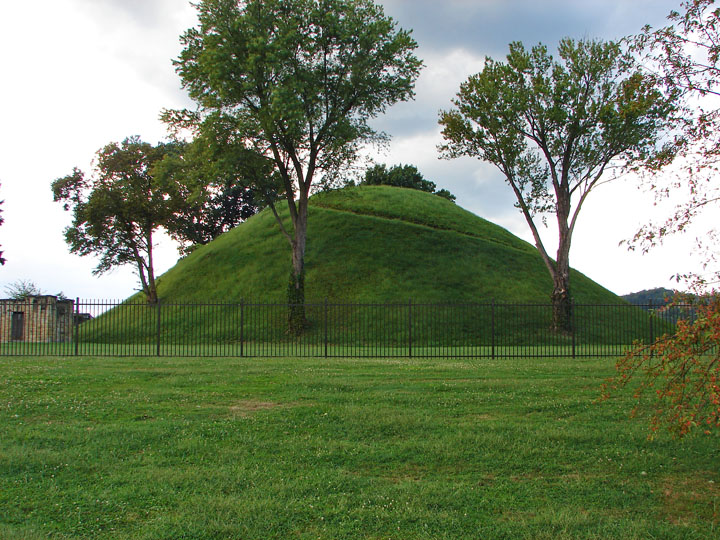
The Grave Creek Stone

Fig. 1.
The Grave Creek Stone
Smithsonian photograph 90-9022
(MS 3146, E.H. Davis Collection, National Anthropological Archives)
The Grave Creek Stone was discovered in 1838 during the excavation of the Grave Creek Mound, in Moundsville, West Virginia, on the Ohio River, about 10 miles south of Wheeling. The stone, an actual photograph of which appears in Figure 1 above, was a small inscribed sandstone disk, about 1 7/8″ (4.8 cm) wide, and 1 1/2″ (3.6 cm) high. The reverse side was uninscribed.
In 1838, the mound was reported to have been 69 feet high and 295 feet in diameter at the base, making it the largest of the Adena mounds. Today the mound is preserved in the Grave Creek Mound State Park. According to the Park website, the mound is currently believed to have been built between 250 BC and 150 BC. Figure 2 below shows the mound in its present condition. Note the relative size of the cars and house
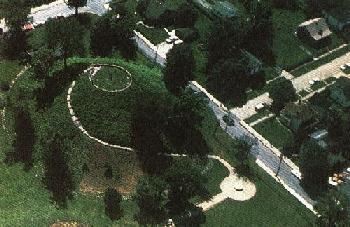
Fig. 2
The Grave Creek Mound today
Lifted from Home in West Virginia website.
It is not known where the stone itself is today. In 1868 it was in the collection of E.H. Davis, of Squier and Davis fame, before most of Davis’s collection was sold to the Blackmore Museum, now part of the British Museum. Fig. 1 above, the only known photograph of the actual stone, is cropped from a photograph of items 60 – 65 of the Davis collection taken shortly before the sale. Nevertheless, the British Museum’s North American Ethnographic Collection confirms that the Grave Creek Stone is not at present in the Museum’s Squier and Davis collections (personal communication, 12/4/89). According to Barnhart (1986, p. 124n), the stone was probably in the collection of Wills de Hass at the time of his death in 1910, and may have passed from there “to parts unknown.” De Hass’s papers are preserved in a library in West Virginia, and may provide some information, or even contain the stone itself, but I have not checked this out.
In 1868, however, Davis made a plaster cast of the stone and deposited it in the Smithsonian Institution. In 1990, Donal Buchanan and I visited the Smithsonian’s National Museum of Natural History in order to view the cast and to check out rumors that the Smithsonian had the original. The NMNH in fact has four casts of the stone, but no original.
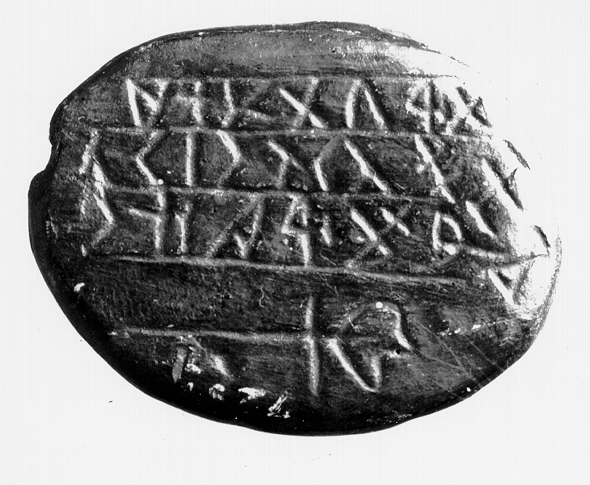
(C) Smithsonian Institution Fig. 3.
Cast of the Grave Creek Stone.
Smithsonian Institution Photograph No. 6768
(Catalogue No. 7252)
Two of the casts have catalog number NMNH 7252, one NMNH 138470, and one NMNH 325934. The darker of the two 7252s, which I call 7252 #1, is painted realistically and signed at the bottom of the front in pale white ink, “E.H. Davis W. Va.” It is shown in Figure 3 above. The white marks under the figure at the bottom are just the remnants of Davis’s signature, upside down. The second, lighter colored NMNH 7252 #2 and the two higher numbered casts appear to be derivative casts made from the above NMNH 7252 #1.
The National Anthropological Archives (MS 3146, E.H. Davis Collection) also has a wax impression of the stone that Davis made at the same time. It is unprotected and badly cracked, but confirms some details that do not show well on the cast. In particular, it clearly shows an X-shaped letter at the left end of the second line, and a lozenge- or diamond-shaped letter at the left end of the third line, that only partially “took” on the cast.
Our inspection confirmed the view of Charles Whittlesey, (1876) that the drawing by Capt. Seth Eastman, which appeared in Henry R. Schoolcraft’s 1850 Indian Tribes of the United States, was the only reliable drawing of the stone, of the six depicted by Whittlesey. Unfortunately, many of the early scholars who made serious attempts to interpret the inscription, including Rafn, Jomard, and Bing-Lvy, worked from seriously inferior copies of the stone. This may at least in part account for the total divergence of the early interpretations, as to both language and content.
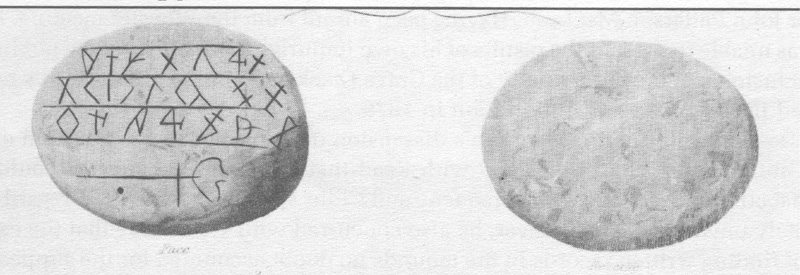
Fig. 4
Photocopy of Seth Eastman drawing of Grave Creek Stone
from Henry R. Schoolcraft Indian Tribes of the United States, 1850,
by way of Barnhart (1986).
(added 2/08)
It should be noted that although Whittlesey (1876, p. 2) presents what he calls a “Copy of Grave Creek Stone — No. 1. by Captain Eastman, United States Army,” what he shows is not actually Eastman’s copy of the stone, but rather a redrawing of Eastman’s copy. Furthermore, his redrawing differs in two important respects from Eastman’s — First, Eastman draws the leftmost letter in the first line with its two verticals meeting at the bottom to form a “V”, whereas Whittlesey has them more nearly parallel, and distinctly open at the bottom. And second, Eastman correctly draws the leftmost letter on the third line as a lozenge or diamond that closes at its top, whereas Whittlesey draws this letter to be distinctly open at the top. In a second, 1879 article, Whittlesey includes his redrawing of Eastman again, with the somewhat misleading explanation, “I insert again the only correct copy made by Captain Eastman, United States Army, from the original in 1850, for Schoolcraft’s Indian Tribes.” Williams (1991, p. 84) also reproduces Whittlesey’s 1876 illustration, giving an 1879 article by M.C. Read as his immediate source.
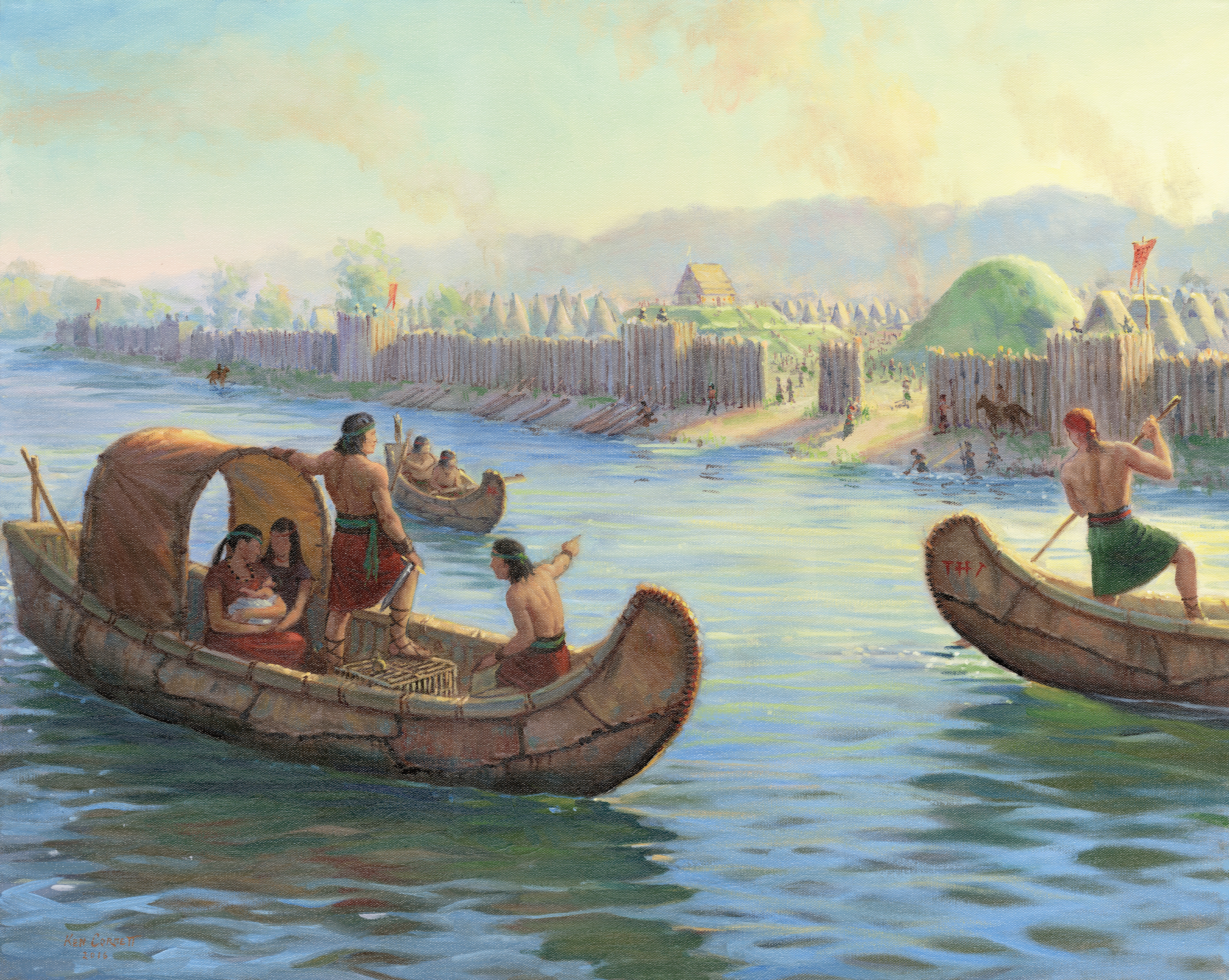
Below is my own attempt to draw the inscription, based on a tracing of the above photograph of the cast, supplemented by our inspection of the actual cast and wax impression.
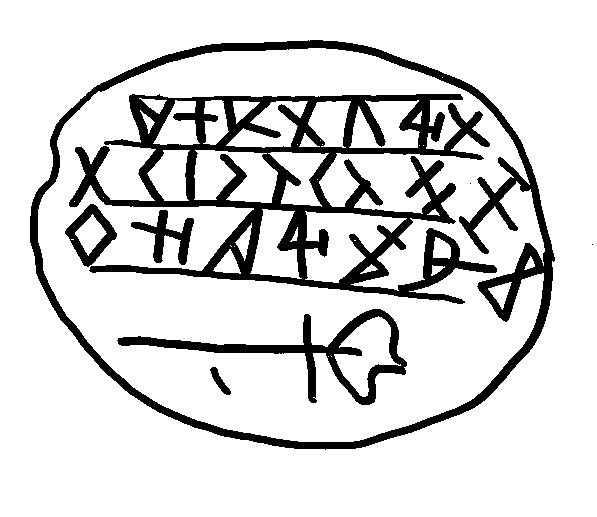 Fig. 5.
Fig. 5.The Grave Creek Inscription
It is not obvious from the inscription itself whether the lines are to be read from left to right or right to left, or perhaps even back and forth or “boustrophedon.” It is not even obvious which end of the stone is the top. Many of the letters are invertible top for bottom, and two actually appear along with their own inverse. I have merely followed the universal convention of placing the figure at the bottom.
The horizontal guide lines are more shallow than the letters themselves, and are not part of the inscription. In Figure 5 below, I have eliminated them and separated the lines for clarity.
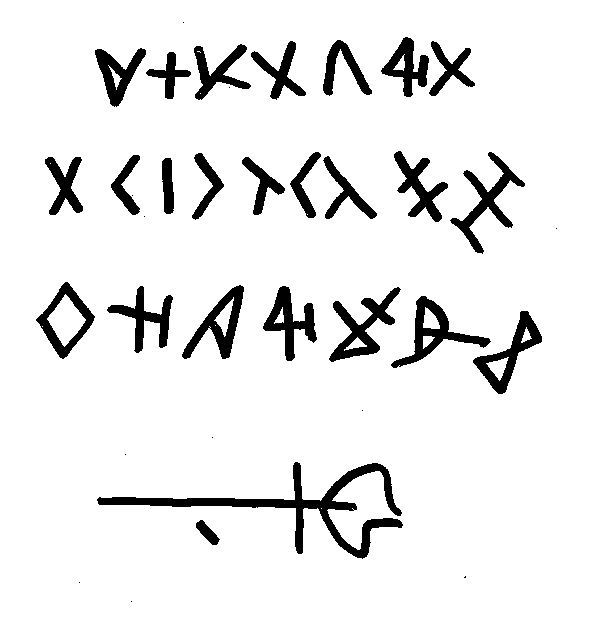 Fig. 6.The Letters of the Grave Creek Inscription
Fig. 6.The Letters of the Grave Creek InscriptionThe principal difference between my drawing and Eastman’s is that in the D-like second letter from the right in the last line, Eastman has drawn the crossbar as a faint wavering line, which one might interpret as a stray scratch, while in fact it is straight and bold, and definitely part of the letter. I have drawn the vertical of the “D” to extend down below the crossbar to meet the loop, as Eastman did, since this appears to be what was intended. However, this continuation in fact is not very clear on either the cast or the wax impression. It is therefore not inconceivable that the vertical only extends down to the crossbar, as it appears in Whittlesey’s Copy #2, from the American Pioneer, May 1843, and Copy #3, used by Jomard.
 Historian Terry Barnhart has recently published an excellent overview (1986) of the 19th century controversy over the authenticity of the Grave Creek Stone. Schoolcraft, Wills de Hass, and J.P. MacLean supported its authenticity, while E.G. Squier, Davis, and M.C. Read regarded it as a forgery. Barnhart’s most interesting observation is that in 1847, Squier had made much of the “singular omission” of any mention of the stone in Dr. James W. Clemens’ first-hand, day-by day account of the excavation, which appeared in S.G. Morton’s 1839 Crania Americana. In 1858, however, de Hass managed to produce the manuscript original of Clemens’ account, and demonstrated that Morton had merely taken it upon himself to expurgate the stone’s discovery from the published version. Dr. Clemens in fact recorded the inscribed stone on the day of its discovery.
Historian Terry Barnhart has recently published an excellent overview (1986) of the 19th century controversy over the authenticity of the Grave Creek Stone. Schoolcraft, Wills de Hass, and J.P. MacLean supported its authenticity, while E.G. Squier, Davis, and M.C. Read regarded it as a forgery. Barnhart’s most interesting observation is that in 1847, Squier had made much of the “singular omission” of any mention of the stone in Dr. James W. Clemens’ first-hand, day-by day account of the excavation, which appeared in S.G. Morton’s 1839 Crania Americana. In 1858, however, de Hass managed to produce the manuscript original of Clemens’ account, and demonstrated that Morton had merely taken it upon himself to expurgate the stone’s discovery from the published version. Dr. Clemens in fact recorded the inscribed stone on the day of its discovery.
 In 1877, the Ohio State Archaeological Society appointed a committee to study the authenticity of the stone. Committee member M.C. Read published a strong denunciation, that included a widely cited experiment to determine if the inscription was alphabetic: He asked four persons who had no training in ancient inscriptions to fabricate twenty or more arbitrary “letters” composed of straight lines and combinations of straight lines. “The result, said Read, was that ‘In every case an inscription was produced presenting as many indications of being alphabetical’ as that on the Grave Creek stone. Accordingly, Read concluded that the Grave Creek inscription was ‘just such a medley of characters as anyone would produce who undertook to invent an inscription to puzzle the curious.'” (Barnhart 1986 p. 120)
In 1877, the Ohio State Archaeological Society appointed a committee to study the authenticity of the stone. Committee member M.C. Read published a strong denunciation, that included a widely cited experiment to determine if the inscription was alphabetic: He asked four persons who had no training in ancient inscriptions to fabricate twenty or more arbitrary “letters” composed of straight lines and combinations of straight lines. “The result, said Read, was that ‘In every case an inscription was produced presenting as many indications of being alphabetical’ as that on the Grave Creek stone. Accordingly, Read concluded that the Grave Creek inscription was ‘just such a medley of characters as anyone would produce who undertook to invent an inscription to puzzle the curious.'” (Barnhart 1986 p. 120)
Committee member Rev. J.B. MacLean, on the other hand, published his own article in which he “did not hesitate to pronounce its authenticity as incontestable…. Regardless of who found the stone or whether it was discovered inside or outside the mound, all professed witnesses agreed it had come from the mound. To MacLean, this was the unassailable preposition.” (Barnhart 1986 p. 122)
Barnhart’s discussion stops short of the two influential articles by Charles Whittlesey, already mentioned above. The first, entitled “Archaeological Frauds,” (1876) deals at length with the Grave Creek Stone. Whittlesey ominously cites Squier’s finding that “Dr. Clemens, in his first account of the opening of the mound, makes no mention of this stone” (p. 5), but himself makes no mention of de Hass’s correction of this misconception.

Whittlesey condemns the inscription itself on the very peculiar grounds that even “If the Grave Creek find was free from suspicion as to its integrity, it has undergone so many mutations from transcribers and translators that its value to ethnologists is gone.” (1876, p. 5) Whittlesey himself had already demonstrated that most of the copies that had been made of the stone were unreliable. However, even though these inaccurate copies created considerable unfortunate confusion among scholars, they in no way altered the inscription itself or in any way lessened any ultimate value it might have to ethnologists.
It was also true that the many attempts at translation differed completely as to substance and even purported language and alphabet. However, this does not demonstrate that none of the proposed translations could be of any merit, but merely that at most one could be of any merit. Even if they all proved erroneous (which Whittlesey did not even begin to attempt to demonstrate in either of his articles), it still would not follow that there could never be a valid translation. Nor would they in any way hamper any future valid translation. In any event, the disagreement among the translations may have been more the fault of the bad copies the translators had to work with than of the inscription or of the translators themselves.
Whittlesey concludes that “The best authorities in the United States have condemned it during many years. The preponderances of proof as well as of probabilities are decidedly against it.” (1876, p. 5) The very title of his article clearly classifies it as a fraud.
 In his second, 1879 article, entitled “The Grave Creek Inscribed Stone,” Whittlesey intriguingly backs off his earlier position that the stone itself is a clearcut hoax. Instead, he now merely insists that the inscription is not alphabetic: “I agree with Prof. Read that the characters on the stone, by whomsoever they were cut, are not alphabetical or phonetic. If they have any meaning and are not a mere jumble of characters they must be symbolic or picture writing. It is therefore of small consequence whether the stone is antique or modern, whether it is genuine or a fraud.” (p. 66) He concludes, “If Professor Read and myself are right in our conclusions, that the figures are neither of the Runic, Phonician, Canaanite, Hebrew, Libyan, Celtic, or any other alphabet language, its importance has been greatly overrated.” (p. 68)
In his second, 1879 article, entitled “The Grave Creek Inscribed Stone,” Whittlesey intriguingly backs off his earlier position that the stone itself is a clearcut hoax. Instead, he now merely insists that the inscription is not alphabetic: “I agree with Prof. Read that the characters on the stone, by whomsoever they were cut, are not alphabetical or phonetic. If they have any meaning and are not a mere jumble of characters they must be symbolic or picture writing. It is therefore of small consequence whether the stone is antique or modern, whether it is genuine or a fraud.” (p. 66) He concludes, “If Professor Read and myself are right in our conclusions, that the figures are neither of the Runic, Phonician, Canaanite, Hebrew, Libyan, Celtic, or any other alphabet language, its importance has been greatly overrated.” (p. 68)
After Whittlesey’s two articles the Grave Creek Stone was generally dropped from serious consideration by archaeologists, except as a textbook example of an established hoax. It was so thoroughly discredited that they even lost track of its whereabouts.
Wills de Hass was appointed to head the Smithsonian Bureau of Ethnology’s Mound Survey project, but was quickly replaced in favor of Cyrus Thomas. It is not unlikely that this had something to do with his favorable position toward the Grave Creek Stone. Thomas, on the other hand, “took a very strong, almost sarcastic, stance toward the Grave Creek Stone and Schoolcraft’s support of it.” (Williams 1991, p. 86)
 A 1930 article in Science News Letter reported in all seriousness that one Andrew Price had at last “cleared up one of the greatest hoaxes in the record of American science,” by translating the Grave Creek inscription into “good old West Virginian.” (Davis 1930) According to the article, “That hoax, perpetrated by some unknown practical jokesmith, has stood triumphantly undetected for ninety odd years.” The inscription, according to Price, reads, in plain English,
A 1930 article in Science News Letter reported in all seriousness that one Andrew Price had at last “cleared up one of the greatest hoaxes in the record of American science,” by translating the Grave Creek inscription into “good old West Virginian.” (Davis 1930) According to the article, “That hoax, perpetrated by some unknown practical jokesmith, has stood triumphantly undetected for ninety odd years.” The inscription, according to Price, reads, in plain English,
Price claims that this hoax was inspired by Charles Dickens’ The Pickwick Papers, published just the year before the Grave Creek mound was opened. In Dickens’ novel, Mr. Pickwick discovers a stone bearing the following cryptic inscription:
B I L S T
U M
P S H I
S. M.
A R K
After Pickwick announces that he has unearthed “a curious inscription of unquestionable antiquity,” the message is ignominiously deciphered as reading
A diagram accompanying the Science News Letter article indicates that Price interprets the three lines on the Grave Creek Stone as follows:
P S S T O N E
O C T-1 4-1 8 3 8
 Over these letters is a transcription of the inscription that is bad beyond Whittlesey’s wildest imagination. Letters are pushed together or pulled apart and lines added or ignored wherever convenient. Letters from different lines are even joined together, and in several cases letter portions are used more than once in this manner. Even this mutilated transcription must be tortured beyond endurance before it will confess to Price’s reading.
Over these letters is a transcription of the inscription that is bad beyond Whittlesey’s wildest imagination. Letters are pushed together or pulled apart and lines added or ignored wherever convenient. Letters from different lines are even joined together, and in several cases letter portions are used more than once in this manner. Even this mutilated transcription must be tortured beyond endurance before it will confess to Price’s reading.
The Bil Stumps reading is an amusing spoof that has no true relation to the inscription. Even Williams (1991, p. 87) concurs in this assessment. The only hoax here was that the likes of Science News Letter fell for Price’s “solution.”
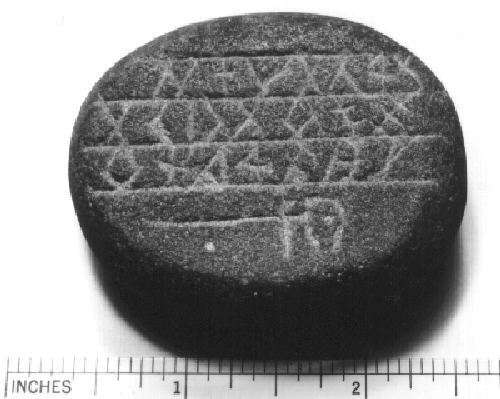
Figure 7.
The Hough Stone
Photo courtesy Robert B. Miller, Jr.
[Added 8/31/00]
In 1951, Philip R. Hough purchased for $1 an inscribed stone from an assemblage of unprovenienced Indian artifacts offered for sale by a gun dealer near Steubenville, Ohio. Hough sent a rubbing of the stone to the Smithsonian. He was informed that it closely resembled the Grave Creek stone, and might either be the original or a clever copy. Hough duly reported his find and its circumstances in a note in the Tennessee Archaeologist (1952).
In 1988, Hough’s grandson Robert B. Miller, Jr., then of Richmond Va., sent a photograph of the Hough stone to the late Victor Moseley, then president of the Midwestern Epigraphic Society. Moseley passed the photo on to me, which is displayed in Figure 6 above.
A close comparison of the Hough stone to the cast shown in Figure 3 above reveals, unfortunately, that it is not the original Grave Creek Stone. Its guide lines are too straight, too evenly spaced, and too parallel. Furthermore, the vertical alignment of the letters does not match that on the cast. It is, however, definitely a deliberate modern copy of the Grave Creek stone, and not, like the Braxton Creek and Ohio County stones, a possible corroborating inscription in the same script. There is no evidence that whoever made it was attempting to pass it off as the genuine article, and Hough is to be commended for his straightforward reporting of the matter.
Modern interest in the stone has been revived, at least among amateurs like myself, by the late Barry Fell in his 1976 book America B.C. (1976a, p. 21, ch. 11). Fell offers yet another entirely different translation of the inscription, stating that the script is Iberian and the language Punic:
This tile
(His) queen caused-to-be-made.
He argues that although the Iberian script was already known in 1838, the phonetic values of the letters were not completely understood until the publication of Diringer’s The Alphabet in 1968, so that if the inscription yields an intelligible translation using these values, it must be genuine.
Fell provides the details of his translation in (1976b). In this article, he generally follows Eastman’s drawing of the stone. However, it should be noted that he adds a short foot to the third letter from the left in the second line, and then reads it, together with its two neighbors, as a single letter (a Semitic shin). I see no evidence of a foot or any connection at the base apart from the guideline, which should not be taken as part of the inscription, and believe this group should instead be read as three separate letters. I have no idea how this change would alter sense of his reading.
Fell’s translation is incorporated into an exhibit about the stone in the Delf Norona Museum at the Grave Creek Mound State Park. The replica of the stone on display there is not an actual cast of the original stone, but merely an artist’s reconstruction based on Eastman’s drawing.

The Grave Creek Stone plays the lead role in Chapter 4 of Stephen Williams’ 1991 Fantastic Archaeology, entitled “The American Humbug: They’ll Believe Almost Anything!” Williams initially has the stone first noticed by Schoolcraft five years after the excavation among some artifacts taken from the mound by its owner, Abelard Tomlinson. In his next paragraph, however, Williams indicates that Tomlinson actually exhibited the stone about two years after the excavation (p. 82). Either way, he warns, following Samuel F. Haven, that the claim that the stone came from the mound was greatly “weakened by the time that purportedly elapsed between its discovery and the announcement of the find” (p. 84). He makes no mention of de Hass’s 1858 demonstration that Clemens in fact recorded it on the day it was found. Instead, he cautions the reader that “the problem of a time delay is a common thread running through a number of Fantastic Archaeology cases” (p. 85).
Williams places great weight on Read’s experiment to determine that the inscription is not alphabetical. “Read … says: ‘It [the inscription] is precisely of such character as would be the result of an ordinary attempt to manufacture an inscription’ and that any of the laborers could have made it. Read’s well-structured and careful testing should have laid the question of the Grave Creek inscription to rest.” (p. 86)
Williams’ overall assessment of the stone, echoed in the title of his chapter, is, “Bah, humbug, Mr. Tomlinson.” (p. 87)
In a critical review of Williams’ book, philologist David H. Kelley deals at length with Williams’ treatment of the Grave Creek Stone. Kelly is the author of Deciphering the Mayan Script, a 1976 text that was instrumental in establishing the phonetic character of the Mayan glyphs. He considers as entirely appropriate Schoolcraft’s much-ridiculed, if inconclusive, attempt to identify the alphabet of the inscription.
Kelley writes, “I have a hard time criticizing the view that the inscription is non-alphabetic, for that seems to me an obvious fantasy. I think that anyone who could not recognize that obvious fact should, ipso facto, disbar himself from any serious discussion of the problem. Williams praises an ‘experiment’ by Read to determine what geometric forms would be produced by a teacher, a schoolgirl, a druggist, and a college professor asked ‘to write down twenty or more arbitrary symbols, not resembling any characters known to them and using only straight lines.’ This rubbish is utterly irrelevant to the question of alphabets. If one can match an inscription to a specific alphabet or even to a closely related group of alphabets, it is alphabetic; otherwise, it is not. Inventing imaginary systems (by people familiar with alphabets) seems to have been a useful propaganda device, but such systems do nothing to support Read’s conclusion that any of the labourers could have invented such an inscription. ‘Bah, humbug, Mr. Read.'” (1995, p. 12)

Kelly goes on to discuss the similar Braxton Creek and Ohio County inscriptions mentioned by Fell, and concludes, “My major point, however, is not to argue that the inscriptions are, indeed, genuine, but rather that I do not find it fantastic to think that they may be. Williams’s account makes the Grave Creek inscription look like obvious humbug, but he did not know many important facts which supported Tomlinson’s account of the find, and he completely misinterpreted Schoolcraft’s comparisons…. Williams’s book …. should not be used as a bludgeon against looking at important but unusual data and trying to put such data in a genuinely appropriate archaeological context.” (pp 13-14)
Most recently, Rev. C. Edward Smith, Jr. (1998) has made a detailed study of Fell’s (1976b) translation of the Grave Creek inscription. Smith argues that Fell’s interpretation of the text as Punic does not work at all, even taking his letter values as given. Personally, I couldn’t tell Punic language from Arabic, but Smith cogently maintains that Fell doesn’t seem to see the difference either, using as he does Wehr’s Arabic dictionary to read Punic. Both are Semitic languages, but they belong to different branches of the family, and are evidently quite different in many pertinent respects.
Smith attempts no evaluation of Fell’s interpretation of the letters themselves as Iberian script, nor of the authenticity of the stone. He concludes, “we simply do not know — at this point in time and history — what the Grave Creek Stone says — only what it does not say.”
The Grave Creek Stone is long lost. It may turn up some day, but in the meanwhile, a surviving cast, a wax impression, Eastman’s drawing, and even a fuzzy photograph of the original give us an adequate indication of its appearance. The Hough Stone is a good copy, but regrettably is not the original.
Although it was amateurishly excavated, and years later there were numerous discrepancies about the details of its discovery, by all accounts it came out of the interior of the mound. Dr. Clemens documented the inscribed stone on the day of its discovery, even though Morton cut this account from the published version of Clemens’ report. There is no particular reason to think the stone is fraudulent.
Although David Kelley regards the inscription as obviously alphabetic, there is still no solid confirmation of Barry Fell’s identification of the script as Iberian. Fell’s translation of the language as Punic has been sharply criticized by Edward Smith. Perhaps future study will establish a consensus about the alphabet, the language, and/or the message.

(Left) Dr. Walter Hough (1859-1935), curator of ethnology, U.S. National Museum, Smithsonian Institution, shown holding a rare cast of the Grave Creek Mound inscription which has been in the museum for more than half a century. The original stone disappeared years ago.
References
Barnhart, Terry A. “Curious Antiquity? The Grave Creek Controversy Revisited.” West Virginia History 1986, pp. 103-124.
Davis, Emily C. “Printer’s Knowledge of Dickens Solves Scientific Hoax,” Science News Letter 17: 234-5, 1930.
Fell, Barry. America B.C. New York Times Books, 1976a.
Fell, Barry. “The Etymology of some Ancient American Inscriptions,” Epigraphic Society Occasional Publications Vol. 3, No. 76 part 2, Sept. 1976b.
Hough, Philip R. “My Part in the Story of the Grave Creek Tablet,” Tennessee Archaeologist Vol. 8 #2, Summer 1952, pp. 47-48.
Kelley, David H. “Epigraphy and Other Fantasies,” The Review of Archaeology, vol. 15, #2 (April 19, 1995), pp. 8-14.
Smith, C. Edward, Jr. “What the Grave Creek Stone Does not Say: An Epigraphic and Philological Analysis.” PO Box 96, Colerain, OH 43916. Revised Jan. 1998, June 2006.
Whittlesey, Charles. “Archaeological Frauds,” Western Reserve and Northern Ohio Historical Society Tract No. 33, Nov. 1876, pp. 1-7.
Whittlesey, Charles. “The Grave Creek Inscribed Stone,” Western Reserve and Northern Ohio Historical Society Tract No. 44, April 1879, pp. 65-68.
Williams, Stephen. Fantastic Archaeology: The Wild Side of North American Prehistory. University of Pennsylvania Press, 1991.
Return to Archaeological Outliers page. Page written and maintained by J. Huston McCulloch
Send comments to: [email protected]
Drawings on this page may be freely downloaded and copied, with credit to this website.
Figure 3 may not be used without the permission of the Smithsonian Department of Anthropology.
https://www.asc.ohio-state.edu/mcculloch.2/arch/grvcrk.html

